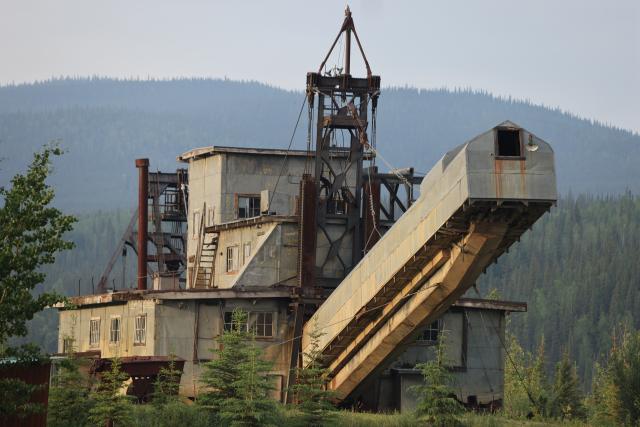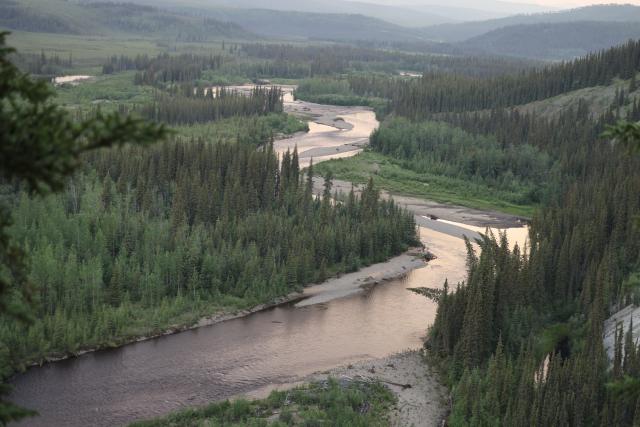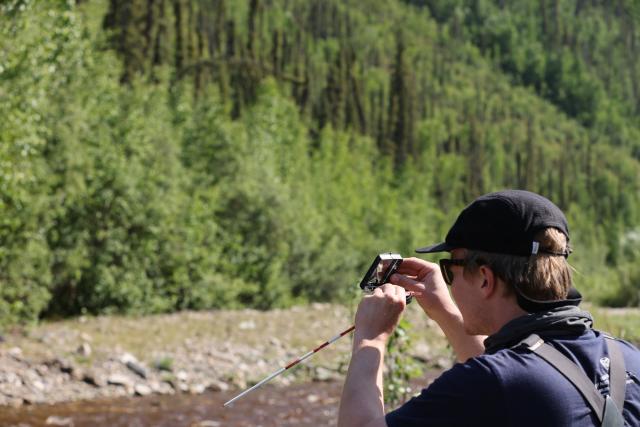You are viewing ARCHIVED content published online before January 20, 2025. Please note that this content is NOT UPDATED, and links may not work. Additionally, any previously issued diversity, equity, inclusion or gender-related guidance on this webpage should be considered rescinded. For current information, visit https://www.blm.gov/blog.
Reclaiming mining’s legacy in Alaska’s Fortymile River
The BLM’s mission and authorities require us to use the latest scientific research, data and findings to ensure that the lands and resources in our care are managed for generations to come. We have a long history of systematically integrating multi-disciplinary science into our land use planning. That integration is more vital than ever, at a time when human impacts on the landscape are growing in both scale and complexity.
In the coming weeks, we will share a series of stories and videos spotlighting how the agency uses science to improve our decision making and ensure that the resources under our care are managed sustainably for generations to come. This is the second in that series.
Click here to watch more about reclaiming on the Fortymile River. BLM video.
Over the last 150 years, BLM-managed public lands have hosted some form of mining activity, ranging from exploration to full mine development. As industry extracted ore, eventually depleting supply, miners abandoned operations or moved to other locations, leaving scarred and contaminated land across much of the West. In many cases, operators did not properly shut down the mine in ways that reduce environmental impact and restore the land.
This is especially true in Alaska, where mining activity dates back to the 1840s. While mining began with a pick and shovel, it often led to the use of large mechanical dredges that ripped up naturally occurring streams for mineral resources like gold and silver.

Mining is part of Alaska’s cultural heritage. But it has left behind degraded streams, impaired water quality, and left hazardous materials in watersheds that support important fisheries and habitat for many other species of wildlife. BLM is working to reclaim and restore degraded streams and fish habitat in Alaska, recognizing the importance of salmon and other native fish to the state’s culture, environment, and economy.
Alaska’s Fortymile River is a prime example. Though designated by Congress as a Wild and Scenic River, the Fortymile saw mining activity for decades that predates this designation.
Unfortunately, experience shows that restoring healthy natural stream functions is more complex than initially thought. Recreating the natural pools, eddies, vegetation, and stream banks necessary to support fish populations requires a much greater scientific understanding of how these components interact with and influence each other.
“For decades, [miners] focused on recontouring the valley, putting the stream path in the lowest part of the valley and letting nature take its course,” says Matt Varner, BLM Alaska Fisheries Resources lead. “What we’ve found over the years is that often falls short of rehabilitating fish habitat. Instream habitat complexity is often lacking.” In many cases the limited recovery of stream habitats can persist for decades if not longer given the Alaska climate. That means streams that may look healthy to the naked eye but aren’t capable of sustaining fish populations and other native aquatic plants and animals that rely on each other in a complex web of interactions.

BLM Alaska land managers realized they needed a much better understanding of stream dynamics and interactions across the state. They also found that data collection from stream restoration projects wasn’t standardized and rigorously collected and analyzed.
This made it hard to understand what techniques and practices were actually making a difference in restoring healthy stream functions. Or to compile best practices that could inform future habitat rehabilitation work, in partnership with mining companies and other stakeholders. Further, determining the natural conditions that potentially existed before mining activity took place was extremely difficult where mining activity dated back more than a century.
BLM Alaska recognized the limited resources available and teamed up with the Bureau’s National Operations Center to facilitate standardized data collection through the Assessment, Inventory and Monitoring (AIM) Strategy’s National Aquatic Monitoring Framework.
By following the Strategy, the team ensured collection of high-quality monitoring data to assess the impact of reclamation requirements and validate stream function metrics as indicators of the health of Alaskan streams. In addition to collecting field-based monitoring data to assess effectiveness of the work, staff also conducted peer-reviewed literature searches.
They found studies that investigated the environmental response and recovery of streams where placer mining had occurred in Alaska. Using this information, they developed a list of monitoring indicators as well as hypotheses concerning the observed responses and recovery times.

This included data evaluating criteria like stream bank condition and stability, in-stream vegetation, the structure and placement of pools and riffles, floodplain connectivity and other useful metrics. And by looking at other healthy streams in Alaska, they determined the range of potential natural stream conditions that probably existed before mining activity occurred. The team continues to refine the process and data collection standards to update and improve success.
Research and data findings, coupled with agency reports and peer-reviewed literature, guide BLM’s efforts to develop related demonstration projects, establish stream best management practice guidance, and conduct training for resource staff on stream design and construction.
The BLM Eastern Interior Field Office’s success laid the foundation for work across the state, helping land managers collaborate more closely and effectively with the mining industry to restore sites, whether new or decades old.
“Working with stakeholders like miners is very important to help maintain that use on the landscape and make sure it’s sustainable over time so that these streams can continue to provide those ecosystem services that other public land users appreciate, whether it’s recreation, fishing, hiking and birdwatching,” said the BLM’s Varner.
The partnership is a positive one from the standpoint of mining operators as well.
“It’s really changing things here in the Fortymile mining district, which it should,” said Dean Race, owner of Race Family Mining, adding that it’s the responsible thing to leave a mine site in the best condition possible. "By partnering, we’re creating an environment that’s sustainable, and that’s the most important thing.”
Building on this foundational work, BLM is using lessons learned to contribute to a significant cross-agency initiative to restore salmon habitat in the Fortymile Wild and Scenic River and across the Yukon, Kuskokwim, and Norton Sound region through the Inflation Reduction Act. BLM invested $5 million to better monitor land and water conditions, improve water quality and aquatic habitat, and ensure safe access for recreation across more than 7 million acres.
It’s one of 21 Restoration Landscapes across the West where BLM and partners are focusing investments in ecosystem restoration and economic resilience for communities that depend on these lands to support their livelihoods and traditions. Infusing funding into these landscapes is engaging partnerships and further multiplying BLM's return on investment on behalf the American people so that future generations can inherit public lands in better condition than we find them in today.
Chris Tollefson, Senior Public Affairs Specialist
Related Stories
- Popular posts: BLM's most viewed blogs of 2025
- Using science to uncover mysteries of the Mesa archaeological site in Alaska
- “Where did my horse come from?” BLM launches a new way for adopters, trainers and others to learn about their wild horses and burros
- Lake Havasu Fisheries Improvement Program is the gift that keeps giving
- BLM is thankful for public lands volunteers
